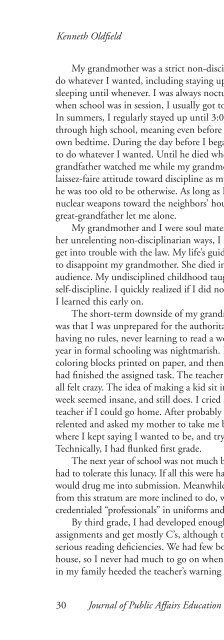WINTER 2012 - National Association of Schools of Public Affairs and ...
WINTER 2012 - National Association of Schools of Public Affairs and ...
WINTER 2012 - National Association of Schools of Public Affairs and ...
Create successful ePaper yourself
Turn your PDF publications into a flip-book with our unique Google optimized e-Paper software.
Cheryl Simrell King<br />
Integrate class into the curriculum. Of course, class is a construct that belongs<br />
in any coursework on diversity <strong>and</strong> cultural competency. Working with students<br />
on the invisible knapsacks <strong>of</strong> both race <strong>and</strong> class is a powerful experience<br />
that situates class <strong>and</strong> oppression within systems <strong>of</strong> invisible privilege <strong>and</strong><br />
demonstrate our complicity in perpetuating these arrangements.<br />
One way to integrate class into the PA curriculum is to do so directly, <strong>and</strong><br />
The Center for Working-Class studies at Youngstown State University <strong>of</strong>fers<br />
both sound advice for teaching about this topic <strong>and</strong> an extensive reading list<br />
on various socioeconomic subjects. (http://cwcs.ysu.edu/teaching/teachingclass/readings).<br />
The Class Action website mentioned earlier also provides good<br />
materials for classroom use.<br />
Kenji Yoshino’s book, Covering: The Hidden Assault on Our Human Rights<br />
(2006), is especially effective in uncovering the things we cover, if you will,<br />
unpacks civil rights, <strong>and</strong> details the social implications <strong>of</strong> doing so. Janet<br />
Galligani Casey’s (2003) article entitled “Diversity, Discourse, <strong>and</strong> the Working-<br />
Class Student” is a powerful piece that addresses the rhetoric <strong>of</strong> diversity <strong>and</strong><br />
how working-class students are not served in contemporary discourse because<br />
the discussion glosses over disadvantages, thereby perpetuating the academy’s<br />
inherent middle-/upper-class ideology.<br />
Discourse defined from such an ideology dominates in most situations,<br />
not just the academy. Therefore it’s not enough just to include class as another<br />
diversity variable. We also must deconstruct <strong>and</strong> unpack the mainstream<br />
assumptions that make class an invisible construct. Therefore, instructors should<br />
do more than simply integrate class consciousness mechanisms into the public<br />
administration curriculum. We also need to inspire students to revise <strong>and</strong> remake<br />
the dominant discourses that privilege certain categories over others <strong>and</strong> thereby<br />
ensure the continuation <strong>of</strong> middle-/upper-class, normative frameworks.<br />
We can indirectly incorporate class into the curriculum by assigning texts<br />
<strong>and</strong> readings that use socioeconomic issues as a central analytic or organizing<br />
framework. The other papers in this symposium do an excellent job <strong>of</strong><br />
identifying relevant texts <strong>and</strong> other materials, <strong>and</strong> I refer readers to these good<br />
works on the topic.<br />
Disempower “covering.” Make the mainstream more inclusive. Inspire students<br />
to do the same in their work. In Transformational <strong>Public</strong> Administration (2005),<br />
Lisa Zanetti <strong>and</strong> I situated the American Dream as a nightmare, one we all need<br />
to awaken from. Outing class in the United States is an important step in our<br />
awakening. To do so, the first step is to situate class theoretically, ideologically,<br />
<strong>and</strong> intellectually. Instructors also need to live the realities <strong>of</strong> these class<br />
differences so we can be more open to others’ experiences. Living the realities<br />
means working to bring more students <strong>of</strong> working-class origins into our PhD<br />
programs, so we can have more pr<strong>of</strong>essors with working-class origins teaching<br />
<strong>and</strong> doing research in the field. We should also analyze our student populations<br />
to see if programs are serving a significant portion <strong>of</strong> students with working-class<br />
origins. If so, it may mean that departments think about departmental strategies<br />
64 Journal <strong>of</strong> <strong>Public</strong> <strong>Affairs</strong> Education

















